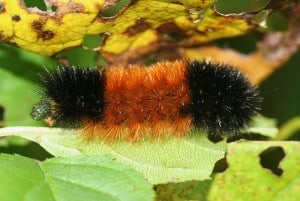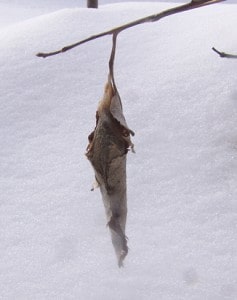If you think from reading the title that you are about to read an excerpt from a steamy romance novel, I am afraid you might be disappointed.
If, however, you have an interest in where moths go during the cold months, then I hope you`ll find the following of interest.
Frozen, quiet, and white, is the landscape at this time of year.
The silent, still air may, for a time, be infiltrated by the laughter of a nuthatch, the flute-like snort of an alarmed deer, or the the warble
of a pair of ravens as they roll through the sky together in early-season courtship. And what about the night? Apart from the occasional hoot of an owl, the mournful lament of distant coyotes, or the sudden crack of a tree as it freezes, much of the winter night seems to be truly asleep.
Although there actually is a lot going on during this sleepy season, there are moments when the lack of sounds brings back not-too-distant memories of the seasons of more abundant audible presence. What natural sounds do we not hear during the winter?
“Most”, I think, would be the best word to answer that question. For instance, many more than half of the bird species that breed here, have flown to distant southern lands, and have taken all of their various chatter, chirps, and songs with them.
Spring-singing amphibians (the frogs and toads) too, have disappeared into mud and leaf litter, and have retreated into a silent absence. We generally do not hear anything from them for months. (Though I now have heard at least once, a spring peeper within every month on the calendar. This will occur in any of the colder months if the temperature rises enough above freezing, and maintains for enough consecutive days and nights, that a few of the little frogs are able to thaw out and utter occasional and very weak “peeps”).
So, what about the insects? In the frozen grip of winter, we no longer hear the piercing grind of the cicadas of summer, the chirps of crickets of early autumn, nor the springtime rattle of June Bugs as they bang about out on the porch after dark. Similarly, (and one of my favorite sounds), the whirling rush of moth wings as they circle my head beneath the porch light, is absent now as well. But, on this frozen January day, “Where have all of those moths gone?”, you might ask. Well, not only are they here, but depending on the species, most are over-wintering in various stages of their life cycles.
Some species, (like the cutworms and other noctuids), and depending on the species, over-winter as adults, or as eggs, as larvae, or as pupae,,, and many are indeed alive and well in the Kawarthas right now! Other species may only be here in one form or another throughout the winter months, while others are believed to only migrate into Ontario each spring/summer season. In the case of the latter, it could also be that some migrate out of the area before winter arrives, and/or otherwise die off here completely each fall.
It is not at all uncommon to see the familiar “Woolly Bear” caterpillar on a mild late autumn (or even mid-winter) day. I have seen them crossing roads, crawling about in the garden, and sometimes moving around through piles of stacked firewood.
And most often during the same milder days that I have heard the much-out-of-season Spring Peeper frogs call out.
Woolly Bear caterpillars are the larval stage of the Isabella Tiger Moth, which is a member of the family “Arctiidae”, and this species over-winters in the larva stage. There is an old wives’ tale that suggests that you can predict the severity of the coming winter, based on the thickness ratio of brown to black colour bands of the Woolly Bears’ bristly coat. Though it may be fun to fancy such an idea, it is simply not true. As the larva sheds its skins throughout the fall, they begin with much more black, and acquire more brown in the last skin stage, (which is called an instar), as they head into late fall. So, if you see a Woolly Bear in September, it might indicate the approach of an entirely different kind of winter, than if you saw the very same individual in November.
A large number of moth species found in this area over-winter in the egg stage. About thirty of these are members of one of my favorite groups – the Catocala, or “underwing moths”. As winter weather deposits snow, ice accretions, and all manner of frozen water upon the branches of trees, beneath the icy coating lies much tiny, suspended life in the form of fertile moth eggs. “Moth seeds” is what I like to call them.
I have, and with great difficulty, managed to find these eggs on occasion, but it is not something I would recommend that one should try, unless one has at least as much patience, as they do a desire to see them. They are most often found in cracks and furrows in the bark of outer branches, where they were “glued” by the female moth with a special adhesive that each egg has to pass through as it is layed. As is the case with all the underwing moths, the eggs have been layed on the various host trees, specific to the particular species of moth, so that when they hatch in May and June, (and once the leaves are out), the proper food is just a short crawl away for the tiny larvae.
So, enough explanation about the very difficult-to-find moth eggs in winter. Lets look for something much easier to find. The Saturnids, (silkmoths), spend their winter here in the pupa stage. Some species in this area, like the Imperial Moth, the Pink-striped Oakworm Moth, and the Rosy Maple Moth, are “earth-pupators”. These are some of the many species of moths that, as larvae, burrow into leaf litter and soil before splitting out of their final larval skin and thus, become a pupa. They wiggle about until they have shaped somewhat of a small, earthen chamber, which to a point, hardens some by the time the pupa has completely transformed . In the case of the saturnids, they will stay in these chambers until the earth has warmed enough in late spring and early summer, and then will split out of the pupal shell, find their way back to the surface, and climb something high enough that their wing veins can fill with fluid and harden without worry of drying mis-shaped, as they might if they were to come into contact with something inhibiting free, open-air expansion.
Some of the other silkmoths, (the species of silk-spinners giving the group its common name), as mature larvae, will find a place on a twig, and spin a silken outer cocoon. Once it has completely covered itself in its outer “sleeping bag”, it will spin a sort of cylindrical container inside the rough outer layers. The inner wall of this will become very hard and smooth. When the caterpillar is ready, it will shrink somewhat, and then split out of itself, and become a naked, brown pupa. This too, will soon harden, and although it may wiggle inside a little when warmed by the sun, it will otherwise be still until spring. Species that you may spot in the winter either attached lengthwise on, or hanging from branches, are the cocoons of Cecropia Moth, Columbia Silkmoth, Polyphemus Moth, and Promethea Moth. The cocoons of others like the Luna Moth (and sometimes Polyphemus), though usually wrapped with silk in the green leaves of the host trees in the late summer, tend to fall to the forest floor in October with the rest of the leaves that fall from the trees then. They are not so often well-secured by silk to branches as some of the other species mentioned.
The Cecropia, Columbia, and Promethea cocoons however, have a strong silk wrap, and to the trained eye, can be quite easy to find in the winter as they are visible on leafless trees. Promethea and Columbia larva rarely wander when it comes time to spin their silken cocoons, and most are usually found on the same individual tree whose leaves nourished the caterpillars throughout the summer. The larvae of the Columbia Silkmoth consume the deciduous needle-like leaves of the Tamarack, and the silken cocoons of that species are most often found on the upperside of very horizontal Tamarack branches in winter.
The hanging, spindle-shaped cocoons of Promethea are most often found hanging near the tips of their two favorite larval host trees – the White Ash, and the Black Cherry. I have found them on a few other species before, but more than 90% of them in this part of the world can be expected to be found on the ashes and cherries. There is often from one to a few Promethea cocoons on a tree, but once in 2007 I found no less than nineteen cocoons on a single small Black Cherry tree!! (Though some were old and vacant, it should be noted that the whole combined lot no doubt represented at least a few generations).
The largest cocoons, (out of which will eventually come the largest moths), are made by the Cecropia larvae. They will either stay put on their host tree, or some will wander off a fair distance before finding a branch or twig upon which to spin a winter sleeping bag. These can be quite large, (up to 4X10cm), and more often than not, are found to be rather solitary compared to Promethea cocoons. If you are hoping to see Cecropia cocoons in winter, groves of Speckled Alder (a popular larval host tree of the species) along lakeside marshes, and in river floodplain habitats are very often good places to start.
If you happen to find one of these, (and it’s minus 25 out when you do), don’t worry too much for the “moth-to-be” contained within. Even though the naked little pupa inside is only wrapped in silk,,, it is wrapped in so much of it, (and is cold-blooded), that it is far more protected from the cold than you are in your many layers of heavy winter clothing. Even if you feel sorry for the moth inside, it is not a good idea at all to bring the cocoon indoors. Once it spends some weeks in a warmed house, it will complete development, and the moth will emerge many weeks before it would have done if left outside in the natural environment where you had found it. It is best to just leave it be, and return, (daily if you can), in late May if the spring has been particularly warm, or during the first week of June, if it has been a cool-to-average spring. They emerge in the morning, and you can see them then, in full splendor! Later that evening, they will take off, mate, and continue their kind.

